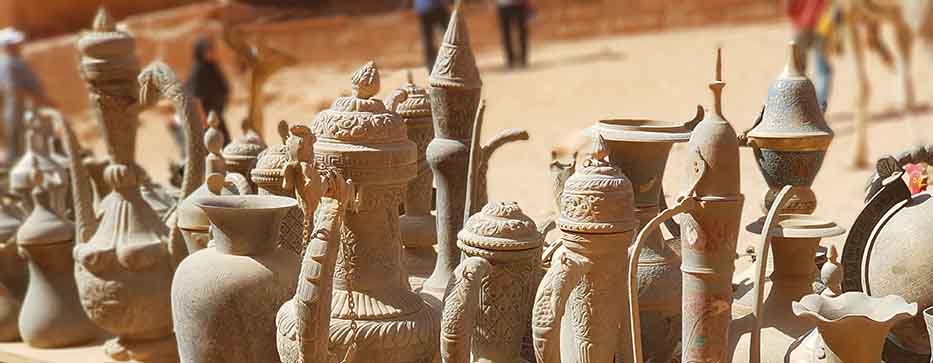It is clear to no one that all Arab countries are true masters of the handicraft. And Jordan It is no exception: in this country traditional objects of great beauty and value are produced, made with great skill and, above all, with a lot of heart. On this page we collect the most interesting of its different disciplines, because they are activities closely related to tourism: we tell you which are the most famous specialties, the places where you can find them, etc.
Although modern machines have been introduced in all economic sectors of the country, including the manufacture of products, the truth is that there is still an interesting Handicrafts in Jordana, by master craftsmen who work with their own hands, with traditional tools and with techniques taught from generation to generation, until they are lost in time immemorial.
And the best ally of Jordanian craftsmanship It is precisely tourism: thanks to the millions of travelers that the country receives every year, this livelihood is sustainable for its humble professionals and even for wider communities, especially in rural areas where cooperatives are often established. Therefore, if during your trip you plan to buy a traditional and representative object of the country, here we show you a selection of them.

Jordan is a textile power in the context of the Middle East, and a good part of its exports are manufactures of this type, as we tell you on the
page dedicated to the economy
. However, it is also possible to find a small-scale artisanal production, with which varied and high-quality items are created. One of the best examples are carpets, whose prestige dates back to Christian and Byzantine times.
They are known as kilims and are deeply rooted in society for their practical function since time immemorial, either to facilitate prayer or to cover the ground in Bedouin tents in the desert, among other examples.
Another textile craft that in Jordan acquires a great quality and diffusion are embroidery. Traditionally made by women, even today many of them, especially the elderly, continue to knit daily, especially traditional costumes and scarves. Among the most famous are the Palestinians, in red cross stitch, who take their name from the neighboring territories on the other side of the Jordan River, but who are actually also widespread on the eastern bank.
It is another great legacy of the Byzantine period and the Roman era in general, since that civilization used them very often to decorate temples and other public and private buildings, especially as a pavement. Quality is usually measured by the size of the tiles (small fragments of stone that form the design) or by their density per centimeter: the smaller the tile, the higher the quality… and higher selling price. Sometimes, these are heavy and difficult to transport items, but many stores facilitate their international shipping by courier. Especially interesting is to know this art in situ
, in one of the mosaic workshops scattered around the country.
The predominant jewels in Jordan are silver, which were once made by Armenian and Yemeni goldsmiths, and which today continue to maintain similar designs and typologies, this time by local artists. Some of them are amulets that are given at special times, such as as a dowry from the husband to the wife at a wedding.
Although copper may seem a not too ‘noble’ material, the truth is that it is widely used in Jordanian crafts.. And masterfully. It is no coincidence that some of the oldest mines in the world (such as Feinan) are located here. This metal is mainly used for the production of everyday objects, such as trays or coffee makers. In some cases, these are antiques made several decades ago, which can add a component of nostalgia and romanticism to the purchase.
If jewelry and metal items are meant to last a lifetime, Jordanian craftsmanship It also covers other products that are much more ephemeral, but just as genuine and pleasant. This is the case of soaps, which not only have the charm of having been made by hand following traditional techniques, but also of using a very special raw material: water from the Dead Sea, whose salinity index is extraordinarily high.

Another discipline that could not be missing on this page about the craftsmanship of Jordan It’s ceramics. The most common objects are vessels of rich colors on a white background, for practical purposes, such as plates, cups or trays. But other simply decorative pieces also abound, such as tiles, amulets or exhibition dishes.
Of all Jordanian handicrafts, this is probably the most surprising, for the chosen support and for its decoration. It was actually a very popular activity centuries ago, in which mosaic designs were often reproduced, but over time it declined for a simple reason: ostriches became extinct in the country due to poaching. On the other hand, thanks to tourism and reintroduction programs of this animal in some natural environments conducive to its life (Azraq), there has been a certain recovery of this craft.
Unlike other North African countries, in Jordan there are not so many souks in the strict sense, understood as labyrinthine shopping districts where all kinds of handicrafts are sold. However, there are areas of special commercial interest where it is possible to find good Handicrafts from Jordan, which can represent an optimal option to buy a souvenir of your trip. Here are some ideas:
In any case, if you are interested in buying handicrafts from Jordan and organize your trip with us, the staff of our agency will know how to tell you which are the most appropriate places to do it, either for their mastery, for their long tradition or for their value for money.
Fill out the form below to receive a free non-binding quote tailor-made by a specialized agency in Jordan.
DMC travel agency specializing in tailor-made trips to Jordan
Mandala Tours, S.L, NIF: B51037471
License: C.I.AN-187782-3
Hello!
Contact one of our travel advisors for commercial assistance.
